Introduction
Jalisco, Mexico, has the most representative cluster of Information Technologies Sector located into the Metropolitan Zone of Guadalajara, Mexico (ITSMZG), headquarters of the Mexico’s ‘Ciudad Creativa Digital’. The ITSMZG has around 200 IT Firms that export 2,000 million USD annually on high value-added service and generate 20,000 jobs in the state (Economista, 2016). At the same time, Mexico has a Digital Broadband (DBD) recent policy, available since 2013, with 2015 data ranking reports (ITU-UNESCO, 2016) for instance: Fixed-Broadband Subscriptions per 100 inhabitants, ranked in the place 52/138 among other issues; all these data are considered a great opportunity to develop the OIN factor. The DBD even increases the promotion of innovations in small and medium enterprises (SMEs) and the productivity with significant savings by reducing the transaction costs. We remind that the SMEs in Mexico are the main source of jobs because they’re representing the 99.8% of all companies in Mexico, which generates 52% of gross domestic product and 72% of jobs in the country.
Problem, Research question and Rationale of the study
We have two remarkable factors, firstly the ITSZMG that is characterized as a sector with advanced OIN practices and secondly the DBD that is considered by the Mexican government as a support and guarantee for its development (Estrategia Digital, 2013). Thus, we determined as a problem, to propose a construct that involves the relationship between the OIN and the DBD, determining and analyzing all the determinant factors related in order to improve all the process of OIN based on DBD to be adapted and applied in the ITSZMG.
So, our research question is posed as: what is the relationship between DBD on OIN in ITSMZG? The rationale of the study is due the ITSMZG interest to know how the main factors of DBD are influencing the OIN process, to identify the weak relationships and to do several suggestions about reinforcement of such relationships proposed, for improvement of the model.
The Specific Research Questions (SRQ) are:
SRQ1. What are the variables proposed for the general conceptual model?
SRQ2. What are the relationships of these variables?
SRQ3. What are the most relevant variables of the model?
Searching the Variables of the Construct
The subjects under study were all the 600 ITSMZG specialists, including: SME CEOs (120), back office/ front office managers (120), software designers (120), professors (120) and directors of business consultant firms (120) all of them grouped in the cluster.
To achieve the proposal of variables of the construct, we went through a literature review of more than 40 papers about models regarding the OIN and SMEs, selecting the main factors, variables and indicators of each one, and listed in a matrix table per author. See Table 1.
 |
Table 1. Authors and variables related with the OIN Factor |
We proceeded to summarize variables vs authors to prepare the account of academic vision. See Table 2.
 |
Table 2. Variables representing the OIN underlying factor |
After this, we proceeded to the qualitative analysis of this research applying focus group with Delphi Panel and Analytic Hierarchy Process (AHP, Saaty, 1997) to 6 ITSMZG specialists, in the following proportion: (SME CEOs: 1; back office/ front office managers: 1; software designers: 1 and professors : 3 as an academic vision) focusing on everyone´s attention and experience, in order to ask for some suggestions to get the best grouping of factors and variables and the best names to associate them to the OIN and DBD construct. The results were, for the OIN factor: Knowledge Management (KMG), Open Business Models (OBM), and Innovation Ecosystem (IEC). See Table 3.
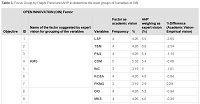 |
Table 3.- Focus Group by Delphi Panel and AHP to determine the main groups of Variables of OIN |
Finally, we used the same procedure for DBD variables, with results showed as: User (USR), Access (AXS), Network (NET), Regulation (REG), Cost & Benefits (C&B), QoS (Quality of Service). See Table 4.
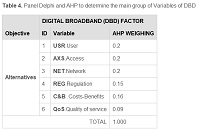 |
Table 4.- Panel Delphi and AHP to determine the main group of Variables of DBD |
Thereby, we proceeded to explain every single factor and variable to determine our general conceptual model of OIN, through the literature review. For practical analysis, we excluded the PKMG, POBM and PIEC dimensions due, these are performance key dimensions of each variable. Hence, we proceeded to explain each of these factors and variables to determine our general conceptual model of OIN and DBD, through deep literature review.
Literature review
The OIN is defined as “a distributed innovation process based on purposively managed knowledge flows across organizational boundaries” (Chesbrough & Bogers, 2014). But, how is affected in the digital era? One of the insights, is the DBD, defined by the OECD (2008a) as: “typically used to denote an Internet connection with download speeds faster than traditional dial-up connections (at 64 kbit/s)” and it is a key driver of economic growth and national competitiveness (Kim, et al.,2010). So, our model proposed here consists in:
Knowledge Management (KMG)
According the OECD (2003): “It covers any intentional and systematic process or practice of acquiring, capturing, sharing, and using productive knowledge, wherever it resides, to enhance learning and performance in organizations”. Hence, we propose a model based on a strong leadership (LSP) of its members (OECD, 2003; Mejía-Trejo et al., 2013) able to establish different mechanisms of communications (COM) to transmit the explicit and tacit knowledge, including training the personnel and mentoring the apprentices (T&M) with policies and strategies (P&S) about rewards and incentives to the personnel (INC) in inbound and outbound knowledge frontiers of the Firm (OECD, 2003; Asakawa et al., 2010; Hughes& Wareham, 2010; West& Bogers 2014). For a best knowledge capture and acquisition (KC&A) (Gassman & Enkel, 2004; OECD 2003; Goglio-Primard, & Crespin –Mazet, 2014; Keup & Gassman, 2009), the incentives to the personnel are recommended (OECD, 2003; Allarakhia et al., 2010).
Therefore, our hypothesis is:
H1. The Higher level of DBD, the higher level of KMG in OIN of ITSMZG
Open Business Model (OBM)
We consider the Osterwalder& Pygneur (2010) definition of business model: “A business model describes the rationale of how an organization creates, delivers, and captures value” So, with the increased adoption of open innovation practices, “open business models” have emerged as a new design theme (Chesbrough, 2007; Chesbrough,2007). Therefore, we propose an OBM concept associated with KMG necessary to potentiate the OI Orientation (OIO) by the definition of exploring it, as the experimenting with new alternatives and/or exploiting it, as the refining and extending of the existing knowledge (Chien-Tzu & Wan Fen, 2014,) and what kind of driver is using, such as: the purchase of technology, licensing, purchase of technology, etc. (OECD, 2008b).
The market segmentation (MKS) as basis to define the services and products specialized to offer to the customer (Osterwalder & Pigneur, 2010) and it represents the opportunity to analyze, different applications of the technology besides the current market such as the discovering and developing new markets or for licensing other Firm’s Market (OECD, 2008b; Chesbrough 2003). The value proposition (VP) is the core of any business, so it should be emphasized in different forms, such as: branding, performance, newness, etc. (Osterwalder & Pigneur, 2010; Mejía-Trejo et al., 2013) and make the user a source of innovation to create value, as a tool to capture value (Chesbrough 2003). The customer relationship management (CRM) as a tool, must be applied in different channels (CHN) (own & partners), in all its different forms, such as: personal service, automated-service, selfservice, etc. (Osterwalder & Pigneur, 2010; OECD, 2008b) emphasizing the co-creation (Rayna & Styriukova, 2014) in network. The revenues streams (RIPR) represent a great chance, for the organizations based on de intellectual property rights (IPR) protection as: patents, trademarks and copyrights, for commercializing them using patent pools or crosslicensing portfolios, for instance (OECD, 2008b).
The key resources (KYR) must be recognized (Osterwalder & Pigneur, 2010) involving tangible (buildings, infrastructure, labs, etc) and intangible (data, information, talent personnel, etc.) assets. The Key Activities (KYA) mainly the R&D network, turns out to be more productive based on absorptive capacity features, knowledge and technology (OECD, 2008b). The minimum of the costs (CST), like fixed-cost, variable-cost, economy-scale, economy-scope, etc. (Remneland-Wikhamn & Knights, D. 2012).
The Partnerships (PTS) represents a solid base to do business, involving the relationship University-Government-Organization-Society (Quadruple Helix) (OECD, 2008b, Miller et al., 2016 ) The technology (TEC), due its capacity to incorporate it in an external or internal way to the organization and aimed to the current or different markets (Chesbrough, 2003).The strategy (STR) applied in different ways: Market-Based Innovation; Crowd-Based Innovation Strategies or Collaborative Innovation;Network-Based Innovation Strategies (Gassmann et al.2010) according different final goals to implement, such as: improvement of revenues performance, competitive advantage, or even more, ensure the secrecy, etc. (OECD, 2008b). Finally, the new entrepreneurships (NWE) successfully achieved are a good indicator of any OBM, such as the spin-in, spin-out and spin-off in certain period. (MejíaTrejo, 2017)
Hence, our hypothesis:
H2. The higher level of DBD, the higher level of OBM in OIN of ITSMZG
Innovation Ecosystem (IEC)
It is considered as: “a network of interconnected organizations, organized around a focal firm or a platform, and incorporating both production and use side participants, and focusing on the development of new value through innovation” (Autio &Thomas, 2014). This IEC in our model is proposed with the next elements to analyze: Types of risk (RSK) such as: cost, the infringement litigation with other companies in a similar and/or different product markets, etc. (OECD, 2008b). The opportunities (OIEC), based on: the potential on how well knowledge flows and the system is connected, a greater sense of urgency for internal groups to act on ideas or technology (OECD, 2008b, Lichtenthaler 2009). The threats (TIEC) such as: the extra costs of managing co-operation with external partners, the lack of control, the potentially opportunistic behavior of partners, (Goglio-Primard, & Crespin –Mazet,2014), the adverse impact of flexibility, overdependence of partners, etc. (Lichtenthaler, 2009). A system of governance (GOV) capable to be elected and recognized, as a key factor for applying the principles of behavioral rules that support and regulate all the transactions by mean of written rules, the process of election of central governance, establishing roles and responsibilities to take decisions, etc.
Our hypothesis:
H3. The higher level of DBD higher level of IEC in OIN of ITSMZG
Digital Broadband (DBD)
One of the insights, is the DBD, defined by the OECD (2008c) as: “typically used to denote an Internet connection with download speeds faster than traditional dial-up connections (at 64 kbit/s)” and it is a key driver of economic growth and national competitiveness (OECD, 2008c; Kim, et al.,2010; Rohrbeck et al. 2009). So, our model proposed here, consists of:
The user (USR), as one of the most important and powerful agent in our conceptual model, because it is an active element involving: surveillance for security/privacy based on protocols and standards, the empowerment of SMEs and users by DBD, the tendency of users with evolving skills to create contents with diversity and new habits in the consumer, (OECD, 2008a; Bianchi et al. 2010) to find out a major communication in your IEC, major communication with the government, etc. increasing the needs of DBD (Wunsch-Vincent & Vickery (2007); Müller-Seitz.& Reger, 2009; OECD, 2006), taking and planning competitive advantage (Kim et al.2010;OECD, 2008b).
About access (AXS), as the ability to connect the backbone network of the telecom operator by mean to use the last mile (wire a non-wireless) (OECD,2008b; Kim et al. 2010) specially asking about Internet: coverage, flexibility, time, speed, cost-benefits ratio, technologies, type of device (fixed and/or mobile). According the network (NET), as the transmission media characterized by: interoperability, speed, connection, with minimum errors (OECD, 2008b; Kim, 2010). The best practices of regulation (REG) by the government (and associations), such as: the actions balance the interests of suppliers and users, protection of IPR about new contents, the promotion of competition in digital model business (OECD, 2006; Biggs & Kelly, 2006) , research & science, education, culture, health, lower prices, etc. providing the greatest benefits for users in different markets, introducing new technologies for access to the net and the universal broadband services (OECD, 2006; Biggs & Kelly, 2006; Sing&Raja (2008). It is a fact about the relation cost per benefits (C&B) increases with regulation and low prices showing in DBD: subscriptions, the network readiness, best offerings of services, etc. (Horrigan & Duggan, 2015; ITU-UNESCO, 2016) with high quality of service standards (QoS) and service level agreements (Kim et al.,2010). Therefore, our hypothesis:
H4. The higher level of DBD, the higher level of OIN of ITSMZG
Hence, we proposed the general conceptual model (see Scheme 1)
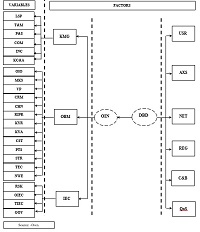 |
Scheme 1:General Conceptual Model |
Notes: LSP.- Leadership ; T&M.-Training and Mentoring; P&S.- Policies and Strategies; COM.-Communication ; INC.-Incentives ; KC&A.-Knowledge capture & acquisition; OIO.- Open Innovation Orientation; MKS.-Market Segmentation ; VP.-Value Proposition; CRM.- Customer Relationship; CHN.-Channels of Distribution; RIPR.-Revenue Streams for Intellectual Property Rights; KYR.-Key Resources; KYA.-Key Activities; CST.- Cost ; PTS.-Partnership; TEC.-Technology ; STR.-Strategy; NWE.-New Entrepreneurships. RSK.- Risk; OIEC.-Opportunities of Innovation Ecosystem ; TIEC.-Threats of Innovation Ecosystem; GOV.-Governance; DBD.-Digital Broadband; USR.-User; AXS.-Access.-NET.- Network; REG.-Regulation; C&B.-Cost& Benefits; QoS.-Quality of Service
And the Final Questionnaire (see Table 5)
 |
Table 5. Final Questionnaire |
Notes: LSP.-Leadership ; T&M.-Training and Mentoring; P&S.- Policies and Strategies; COM.-Communication ; INC.-Incentives ; KC&A.-Knowledge capture & acquisition; OIO.-Open Innovation Orientation; MKS.-Market Segmentation ; VP.-Value Proposition; CRM.- Customer Relationship; CHN.-Channels of Distribution; RIPR.-Revenue Streams for Intellectual Property Rights; KYR.-Key Resources; KYA.-Key Activities; CST.- Cost ; PTS.-Partnership; TEC.-Technology ; STR.-Strategy; NWE.-New Entrepreneurships s. RSK.-Risk; OIEC.-Opportunities of Innovation Ecosystem ; TIEC.-Threats of Innovation Ecosystem; GOV.-Governance; DBD.-Digital Broadband; USR.-User; AXS.-Access.-NET.- Network; REG.-Regulation; C&B.-Cost& Benefits; QoS.-Quality of Service.
Methodology
We started the study involving 600 ITSZMG specialists (including: SME CEOs (120), back office/ front office managers (120), software designers (120), professors (120) and directors of business consultant firms (120) at 200 SMEs all of them grouped in the cluster “Ciudad Creativa Digital) during the period of September-December 2016. The data collection was made through the support of a previous agreement (type: triple helix) among the ITSZMGPROSOFT (Programa para el Desarrollo de la Industria del Software y la Innovación.)- University of Guadalajara. The participants were distributed firstly, in the AHP-Delphi Focus Group, and secondly, in different seminar panels to do the survey of data in four modules: KMG, OBM, IEC and DBD.
We made the quantitative analysis of the research, in order to evaluate the reliability and validity of the measurement scales, using Confirmatory Factor Analysis (CFA) with the maximum likelihood method in EQS 6.2 software (Byrne, 2006). Similarly, the reliability of the proposed measurement scales is evaluated from Cronbach’s alpha coefficient and the composed reliability index (CRI) (Bagozzi & Yi, 1988). All the values from the scale exceeded the recommended level of 0.7 for Cronbach’s alpha as well as the CRI that provides an evidence of confidence that justifies the internal reliability of the scales (Hair et al., 2014). Accordingly, other methods of estimation were used when it is assumed that the normality is present. For this, we followed the suggestions from Chou, et al. (1991) and Hu, et al. (1992) for the correction of the estimation model used. In this way, the robust statistics (Satorra & Bentler, 1988) will be used to provide a better evidence of the statistical adjustments.
The adjustments used, were: the Normalized Adjustment Index (NFI), Not-Normalized Adjustment Index (NNFI), Comparative Adjustment Index (CFI) and the Root Mean Square of Error Approximation (RMSEA) (Byrne, 2006; Hair et al., 2014). The NFI, NNFI and CFI values between 0.80 and 0.89 represent a reasonable adjustment (Segars & Grover, 1993), and a value that is equal or higher to 0.90 is an evidence of a good fit (Byrne, 2006). The RMSEA values that are inferior to 0.080 are acceptable (Hair et al., 2014). The CFA results are presented in Table 6
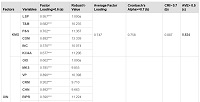 |
Table 6. Internal Consistence and Convergent Validity Evidence of the Theoretical Model |
The theoretical model provides a good fit of data (S-BX² = 453.672; df=405; p < 0.000; NFI = 0.825; NNFI = 0.895; CFI = 0.883; RMSEA = 0.019). As evidence of the convergent validity, the results from the CFA indicate that all the items of the related factors are significant (p < 0.001), the size of all the standardized factorial loads are superior to 0.60 (Bagozzi & Yi, 1988) and the average of the standardized factorial loads of every factor exceed without any problems the value of 0.70 (Hair et al., 2014). Finally, the average variance extracted (AVE) was calculated for every pair of constructs, which results in an AVE that is superior to the 0.50 (Fornell and Larcker, 1981).
In regard to the evidence of discriminant validity, the measurement is given in the following ways:
- With a confidentiality interval of 95%, none of the individual elements of the latent factors from correlation matrix contain the value 1.0 (Anderson & Gerbing, 1988).
- The variance extracted between each pair of constructs is superior to its corresponding AVE (Fornell & Larcker, 1981). See Table 7.
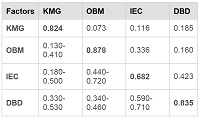 |
Table 7. Discriminant Validity Measuring of the Theoretical Model |
Note: The diagonal represents the AVE, whereas above the diagonal part presents the Variance (the correlation squared). Below the diagonal, is shown the correlation estimation of the factors with a confidence interval of 95%. Source: Own
Based on these criteria, it can be concluded that the different measurements used in this paper show enough evidence of reliability as well as convergent and discriminant validity
Results
In order to prove the hypotheses, a structural equations modeling with EQS 6.2 software by means of CFA of second order was applied (Byrne, 2006) and the theoretical model was analyzed to prove the structure of the model and to get the results that could allow the contrast of the established hypotheses. The nomological validity of the theoretical model was analyzed by the chi-square performance test in which the theoretical model was compared with the measurement model. The results indicate that there are significant differences of the theoretical model are good in the explanation of the relations observed between the latent constructs (Anderson & Gerbing, 1988). See Table 8
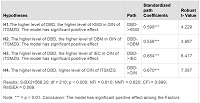 |
Table 8. Structural Equation Modeling Results from the Theoretical Model |
Discussion
Mexico is an emerging country and all the best practices about DBD on OIN by the specialist in ITSMZG, are still with insufficient awareness of their practice or even more, they are still ignored. Hence, the importance of this study to identify the strength and weak relationships to determine a general conceptual model able to predict the best correlations and to improve the model. According the final results showed in Table 4 (only the factor loading > 0.6):
- There are important issues to consider as a result of the visions comparison: academics vs. experts (See Table 3). For instance, OIEC is cited as 7.45 % importance of academic vision vs, 2% of experts’ vision (5.45 as % difference amongst them). Revising the case of PTS with 6.38 % importance of academic vision vs. 2.1 % importance of experts’ vision (4.28 as % difference amongst them). Other similar case is the variable CHN with 1.06% importance of academic version vs. 4.5% importance of experts’ vision (-3.44 as % difference amongst them). Thus, we obtained the three main variables with higher academic differences and chances to be developed in the final OIN to be more practical to the experts’ vision
- The main influences of the DBD on OIN practices in the ITSMZG showed positive effects for KMG factor such as the leadership (LSP), as the most important variable applied because there was a great awareness in the knowledge management practices and the communication of this (COM). This is a result of how workers are on training and mentoring (T&M) programs with policies and strategies (P&S) to promote the knowledge capture and acquisition (KC&A). However, it’s important to be developed (factor loading < 0.6), the promotion of incentive programs (INC) supported in reward systems to reinforce the flow of know how between units.
- The main influences of the DBD on OIN practices in the ITSMZG showed positive effects for OBM factor in the open innovation orientation (OIN) due it is just starting in some new activities, such as: the purchase of technology, joint venturing and alliances. The market segmentation (MKS), is a real practice of needs detection of their consumers with a permanent surveillance of the current and potential market and the constant revision of the value proposition (VP) to create it through the user as a tool to capture value, reinforcing the customer relationship (CRM) to be close of them through several branches of distribution (CHN) including own channels and/or partner channels. Therefore, exist a permanent awareness to optimize the key activities (KYA) and the key resources (KYR) resulting in a remarkable reduction of costs (CST). The partnership, (PTS) is a key factor of the OBM because the reduction of risk and uncertainty, acquisition of particular resources and activities mainly the quadruple helix relationship. The technology (TEC) is a strategic resource due the importance of how is acquired and implemented, based on a market point of view and the internal/external resources. However, it’s important to be developed (factor loading < 0.6), the revenues for intellectual property rights (RIPR) because the lack of clear policies of how to get revenues for commercializing, and the link with strategy (STR) to protect the IPR to get competitive advantage. Finally, is necessary to improve the new entrepreneurships (NWE) indicator, as the ability to get: spin in, spin out and/or spin off businesses
- The main influences of the DBD on OIN practices in the ITSMZG showed positive
effects for IEC factor in the opportunities of innovation ecosystem (OIEC), where the
benefits are from several issues, such as: how well knowledge flows to influence their
national or regional innovation system or how to create value through the knowledge,
among others. The threats of innovation ecosystem (TIEC) are affecting the perception
or experience of the open innovation network threats from: the extra costs of managing
co-operation with external partners; the lack of control; the adverse impact of
flexibility,etc. The governance (GOV) is well done applied in the exchange of
information for the innovation ecosystem, recognizing both, the OIEC and TIEC just in
time, for planning the actions in advance.
However, it’s important to be developed (factor loading < 0.6), the risk (RSK) as a variable for warning of how avoid the risk of costs using innovation intermediaries; management of the creation of cross-licensing agreements, etc. - For DBD, due the firms are on permanent surveillance of security, privacy of protocols
and standards, the user (USR) becomes in the main beneficiary. Firms with a high
broadband equipped labor share, have higher productivity. The results are lower entry
barriers, and lower distribution costs to the final user. Digital technologies enable
individuals to create and use their own digital content and create social, cultural, and/or
economic value for themselves, their communities, or their country, improving their own infrastructure (the last mile network). The Internet connections are increasing the demand
of availability as an important option for users, and therefore, is increasingly the
importance of the access (AXS), with user flexibility in time and location of use,
depending of speed of digital access technologies (fiber optics, DSL, WIMAX, LTE,
PLC, UMTS HSPA, etc.) from their telecom operators to several different devices that
are connected to the network, such as: PC, notebook, the smartphone, tablets and/or other
mobile devices.
There are two important consequences: one of these, is that network (NET) must be adequate for the interoperability of broadband services and applications in several platforms to provide a correct average speed, speed variation and availability of connection and stability with compliance of all the regulations and policies (REG) and allowing finally, the competition promotion, lower prices, trusting more on market forces. The second one, are the costs & benefits (C&B) for using the DBD for instance, the monthly cost of broadband subscription or maintenance cost of the internal infrastructure.
However it’s important to be developed (factor loading < 0.6), the quality of service (QoS), as a remarkable profitability to be improved in sustainability and affordability of their DBD service to create and keep a solid business and innovation ecosystem; service error rate, service failure or degradation due to extensive packet loss, number of retransmissions, lack of responses, etc.
Despite all above mentioned, 5/6 DBD factors have positive effect on 18/23 OIN factors
Conclusion
Hence, we concluded the following important issues:
- The results of the study are important and useful for the ITSMZG specialists, because the purpose of the OIN-DBD model is to identify weak relationships, as opportunities to make suggestions on reinforcing such identified relationships, for model improvement.
- Regarding the Specific Research Question (SRQ1). What are the variables proposed for the general conceptual model? It was applied the literature review and proposed the general conceptual model showed in the Scheme 1 and the final questionnaire (see Table 5), based on AHP and Delphi techniques. This allowed us to obtain an academic and expert vision, with a great opportunity to identify and conciliate the importance of the variables among these visions, into the factors of OIN-DBD model, to do improvements on it
- About the Specific Research Question (SRQ2). What are the relationships of these variables? the findings with Confirmatory Factor Analysis (CFA), reveal the most important factors interacting with factors loading >0.6 (see Table 6). This study concluded in a proposition of DBD-OIN general conceptual model with the relationship of USR-AXS-NET-REG-C&B-QoS representing the DBD underlying factor affecting the KMG-OBM-IEC representing the OIN underlying factor.
- The Specific Research Question (SRQ3). What are the most relevant variables of the model? It is showed in the same Table 6 that leadership (LSP) in knowledge management (KMG), is the most important variable in the empirical model. So, it represents to the ITSMZG an indicator very desirable to maintain, but not the only one into the model.
- Our hypotheses (H):
H1.Higher level of DBD higher level of KMG in OIN of ITSMZG
H2.Higher level of DBD higher level of OBM in OIN of ITSMZG.
H3.Higher level of DBD higher level of IEC in OIN of ITSMZG.
H4.Higher level of DBD higher level of OIN of ITSMZG.
Showed in Table 8, each one of them with significant positive effect among the factors confirms our general conceptual model. - Therefore, our suggestions for ITSMZG to reinforce the weakness relationships revealed
in this current study (low factor loading levels <=0.6, see Table 6), are showed in the discussion section, such as INC (0.570), RIPR (0.590), STR (0.579), NEW (0.567), RSK
(0.500), QoS (0.580).
So, concluding in a practical contribution, we can say that: incentives to the personnel, revenues for intellectual property rights, strategy, new entrepreneurships, risk in the open innovation, they are must be improved, for future studies of the ITSMZG Managers. For other hand, as a knowledge contribution, we can say that with the use of structural equation modeling we are able to propose a OIN-DBD model, enough to identifying the own underlying relationships to improve such model. - The limitations of this study are that customers, suppliers, etc. of the ITSMZG specialists were not questioned. Therefore, other studies could include them, and even more, from other regions of the country.
- For future studies, we recommend the use of variable reduction techniques, such as exploratory factor analysis such as the Varimax main component method, was suggested as a refinement of the model.